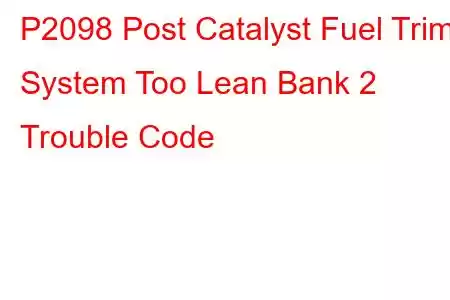P2098 Post Catalyst Fuel Trim System Too Lean Bank 2
OBD-II Trouble Code Technical Description
Post Catalyst Fuel Trim System Too Lean Bank 2
What does that mean?
This is a generic powertrain code, which means it covers all makes/models, 1996-newer. However, specific troubleshooting steps will vary depending on the vehicle.
The code P2098, post catalyst fuel trim system too lean on bank 2 simply translates to a lean (too much air and not enough fuel) condition the PCM recognized through the signals from the oxygen sensors. Bank 2 refers to the side of the engine that does not contain cylinder #1.
A series of oxygen sensors in the exhaust system signal the fuel mixture ratio at all times. Each exhaust system with a catalytic converter will have two sensors -- one between the engine and the converter and one after the converter.
Oxygen sensors signal the engine management computer the amount of oxygen present in the exhaust, which is used in determining and controlling the fuel ratio. The higher the oxygen content the leaner the fuel mixture, conversely the opposite is a rich mixture. It does so in a series of pulses called "cross counts." There is zirconium on the tip of the sensor that reacts to oxygen in a way that when hot, creates its own voltage. It must be around 250 degrees F to operate and will produce up to 0.8 volts.
In operation the oxygen sensor will cycle once every second and send a voltage to the computer that ranges from 0.2 rich to 0.8 for a rich mixture. The perfect mixture will average the signals around 0.45 volts. The computer's target fuel/air ratio is 14.7:1. An oxygen sensor will not function at low temperatures such as start up -- for this reason most forward sensors have a pre-heater to reduce their warm up time.
The mission of the oxygen sensors are twofold -- to indicate the unburned oxygen in the exhaust and secondly, to indicate the proficiency of the catalytic converter. The engine-side sensor signals the mixture entering the converter and the rear sensor signals the mixture exiting the converter.
When the sensors and converter are operating properly, the front sensor will have a higher count than the rear sensor indicating a functioning converter. When the front and rear sensor agree, the front oxygen sensor has failed, the converter is plugged or another component is causing the oxygen sensor to give an erroneous signal.
This code may and may not be noticeable less for the check engine light. It depends on the cause, however, there isn't anything that can fail on a vehicle without adversely effecting something else. Trace the problem to correct the code as soon as possible to avoid damage to any other components.
Symptoms
The symptoms of a P2098 code will vary depending on the component or system causing the disruption in the fuel trim. Not all will be present simultaneously.
Malfunction Indicator Lamp (MIL) illumination with P2098 DTC set Rough idle Poor fuel economy Poor acceleration Misfire Cherry red hot catalytic converter Possible spark knock (detonation / pre-ignition) Additional codes associated with the P2098Potential Causes
The causes for this DTC may include:
Low fuel pressure caused by a clogged filter, failing fuel pump, failed fuel pressure regulator or clogged or leaking injectors. Rough running engine due to misfiring plugs. Many engines have misfire codes to indicate the cylinder effected, such as P0307 for number 7. A large vacuum leak would cause a massive amount of un-metered air to enter the intake manifold resulting in an overly lean mixture. A large air leak at or near the number one oxygen sensor would also cause a lean mixture. A plugged converter will cause of host of driveability problems as well as set this code. A severely plugged converter will result in the inability to increase rpm when under load. Look for a codeRead: 21


